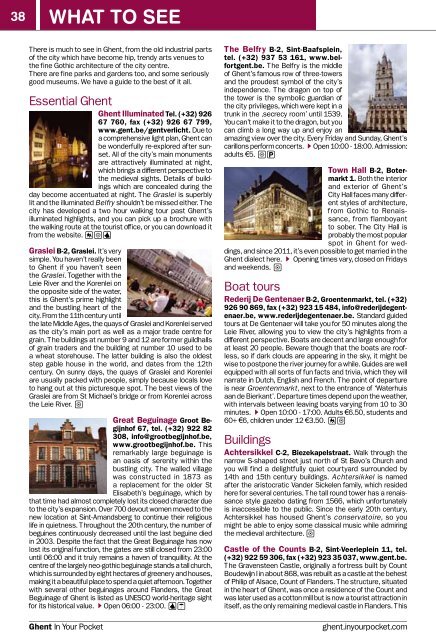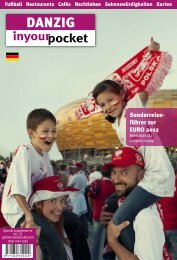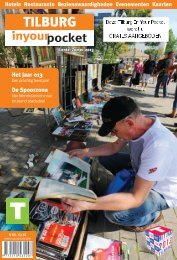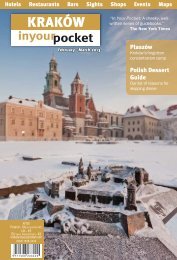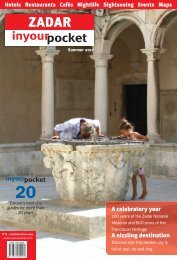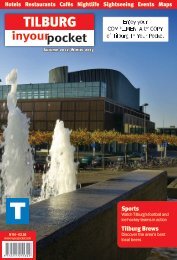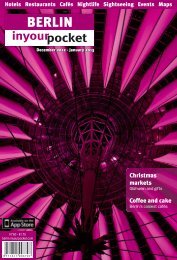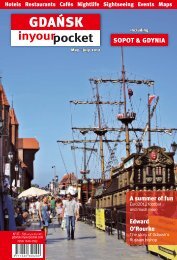Ghent - In Your Pocket
Ghent - In Your Pocket
Ghent - In Your Pocket
Create successful ePaper yourself
Turn your PDF publications into a flip-book with our unique Google optimized e-Paper software.
38 what to see<br />
There is much to see in <strong>Ghent</strong>, from the old industrial parts<br />
of the city which have become hip, trendy arts venues to<br />
the fine Gothic architecture of the city centre.<br />
There are fine parks and gardens too, and some seriously<br />
good museums. We have a guide to the best of it all.<br />
Essential <strong>Ghent</strong><br />
<strong>Ghent</strong> Illuminated Tel. (+32) 926<br />
67 760, fax (+32) 926 67 799,<br />
www.gent.be/gentverlicht. Due to<br />
a comprehensive light plan, <strong>Ghent</strong> can<br />
be wonderfully re-explored after sunset.<br />
All of the city’s main monuments<br />
are attractively illuminated at night,<br />
which brings a different perspective to<br />
the medieval sights. Details of buildings<br />
which are concealed during the<br />
day become accentuated at night. The Graslei is superbly<br />
lit and the illuminated Belfry shouldn’t be missed either. The<br />
city has developed a two hour walking tour past <strong>Ghent</strong>’s<br />
illuminated highlights, and you can pick up a brochure with<br />
the walking route at the tourist office, or you can download it<br />
from the website. TJ6<br />
Graslei B-2, Graslei. It’s very<br />
simple. You haven’t really been<br />
to <strong>Ghent</strong> if you haven’t seen<br />
the Graslei. Together with the<br />
Leie River and the Korenlei on<br />
the opposite side of the water,<br />
this is <strong>Ghent</strong>’s prime highlight<br />
and the bustling heart of the<br />
city. From the 11th century until<br />
the late Middle Ages, the quays of Graslei and Korenlei served<br />
as the city’s main port as well as a major trade centre for<br />
grain. The buildings at number 9 and 12 are former guildhalls<br />
of grain traders and the building at number 10 used to be<br />
a wheat storehouse. The latter building is also the oldest<br />
step gable house in the world, and dates from the 12th<br />
century. On sunny days, the quays of Graslei and Korenlei<br />
are usually packed with people, simply because locals love<br />
to hang out at this picturesque spot. The best views of the<br />
Graslei are from St Michael’s bridge or from Korenlei across<br />
the Leie River. J<br />
Great Beguinage Groot Begijnhof<br />
67, tel. (+32) 922 82<br />
308, info@grootbegijnhof.be,<br />
www.grootbegijnhof.be. This<br />
remarkably large beguinage is<br />
an oasis of serenity within the<br />
bustling city. The walled village<br />
was constructed in 1873 as<br />
a replacement for the older St<br />
Elisabeth’s beguinage, which by<br />
that time had almost completely lost its closed character due<br />
to the city’s expansion. Over 700 devout women moved to the<br />
new location at Sint-Amandsberg to continue their religious<br />
life in quietness. Throughout the 20th century, the number of<br />
beguines continuously decreased until the last beguine died<br />
in 2003. Despite the fact that the Great Beguinage has now<br />
lost its original function, the gates are still closed from 23:00<br />
until 06:00 and it truly remains a haven of tranquillity. At the<br />
centre of the largely neo-gothic beguinage stands a tall church,<br />
which is surrounded by eight hectares of greenery and houses,<br />
making it a beautiful place to spend a quiet afternoon. Together<br />
with several other beguinages around Flanders, the Great<br />
Beguinage of <strong>Ghent</strong> is listed as UNESCO world-heritage sight<br />
for its historical value. QOpen 06:00 - 23:00. 6B<br />
The Belfry B-2, Sint-Baafsplein,<br />
tel. (+32) 937 53 161, www.belfortgent.be.<br />
The Belfry is the middle<br />
of <strong>Ghent</strong>’s famous row of three-towers<br />
and the proudest symbol of the city’s<br />
independence. The dragon on top of<br />
the tower is the symbolic guardian of<br />
the city privileges, which were kept in a<br />
trunk in the ‚secrecy room’ until 1539.<br />
You can’t make it to the dragon, but you<br />
can climb a long way up and enjoy an<br />
amazing view over the city. Every Friday and Sunday, <strong>Ghent</strong>’s<br />
carillons perform concerts. QOpen 10:00 - 18:00. Admission:<br />
adults €5. JL<br />
Town Hall B-2, Botermarkt<br />
1. Both the interior<br />
and exterior of <strong>Ghent</strong>’s<br />
City Hall faces many different<br />
styles of architecture,<br />
from Gothic to Renaissance,<br />
from flamboyant<br />
to sober. The City Hall is<br />
probably the most popular<br />
spot in <strong>Ghent</strong> for weddings,<br />
and since 2011, it’s even possible to get married in the<br />
<strong>Ghent</strong> dialect here. Q Opening times vary, closed on Fridays<br />
and weekends. J<br />
Boat tours<br />
Rederij De Gentenaer B-2, Groentenmarkt, tel. (+32)<br />
926 90 869, fax (+32) 923 15 484, info@rederijdegentenaer.be,<br />
www.rederijdegentenaer.be. Standard guided<br />
tours at De Gentenaer will take you for 50 minutes along the<br />
Leie River, allowing you to view the city’s highlights from a<br />
different perspective. Boats are decent and large enough for<br />
at least 20 people. Beware though that the boats are roofless,<br />
so if dark clouds are appearing in the sky, it might be<br />
wise to postpone the river journey for a while. Guides are well<br />
equipped with all sorts of fun facts and trivia, which they will<br />
narrate in Dutch, English and French. The point of departure<br />
is near Groentenmarkt, next to the entrance of ‘Waterhuis<br />
aan de Bierkant’. Departure times depend upon the weather,<br />
with intervals between leaving boats varying from 10 to 30<br />
minutes. QOpen 10:00 - 17:00. Adults €6.50, students and<br />
60+ €6, children under 12 €3.50. TJ<br />
Buildings<br />
Achtersikkel C-2, Biezekapelstraat. Walk through the<br />
narrow S-shaped street just north of St Bavo’s Church and<br />
you will find a delightfully quiet courtyard surrounded by<br />
14th and 15th century buildings. Achtersikkel is named<br />
after the aristocratic Vander Sickelen family, which resided<br />
here for several centuries. The tall round tower has a renaissance<br />
style gazebo dating from 1566, which unfortunately<br />
is inaccessible to the public. Since the early 20th century,<br />
Achtersikkel has housed <strong>Ghent</strong>’s conservatoire, so you<br />
might be able to enjoy some classical music while admiring<br />
the medieval architecture. J<br />
Castle of the Counts B-2, Sint-Veerleplein 11, tel.<br />
(+32) 922 59 306, fax (+32) 923 35 037, www.gent.be.<br />
The Gravensteen Castle, originally a fortress built by Count<br />
Boudewijn I in about 868, was rebuilt as a castle at the behest<br />
of Philip of Alsace, Count of Flanders. The structure, situated<br />
in the heart of <strong>Ghent</strong>, was once a residence of the Count and<br />
was later used as a cotton mill but is now a tourist attraction in<br />
itself, as the only remaining medieval castle in Flanders. This<br />
<strong>Ghent</strong> <strong>In</strong> <strong>Your</strong> <strong>Pocket</strong> ghent.inyourpocket.com


